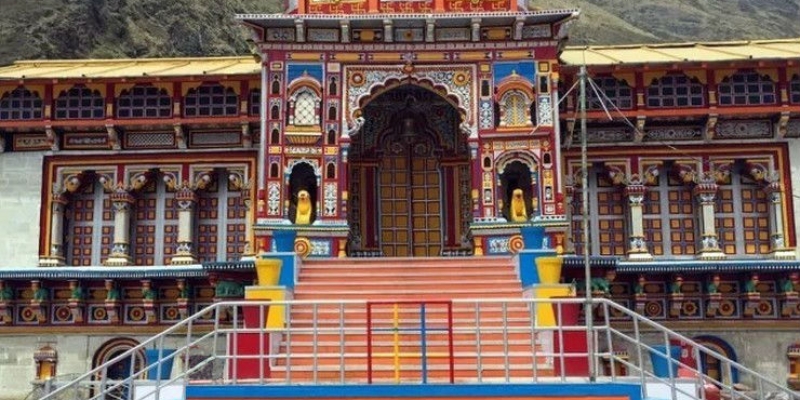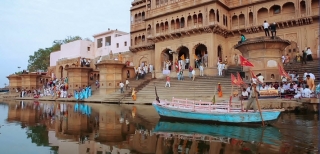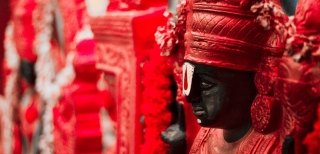Badrinath Dham Hindu places of worship
Badrinath Dham is one of the oldest of Hindu places of worship. Experience the spiritual allure of Badrinath Dham, one of Hinduism's holiest pilgrimage sites nestled in the Himalayas. On the right bank of the river Alaknanda lies the sacred shrine perched at an altitude of 3133 m above sea level, guarded on either side by the two mountain peaks Nar & Narain with the towering Neelkanth peak providing a splendid back-drop. Discover its ancient temples, serene surroundings, and the legend of Lord Vishnu's abode, drawing devotees and tourists alike to this sacred destination. Know more
Badrinath Dham - is one of the oldest of Hindu places of worship. On the right bank of the river Alaknanda lies the sacred shrine perched at an altitude of 3133 m above sea level, guarded on either side by the two mountain peaks Nar & Narain with the towering Neelkanth peak providing a splendid back-drop. Also known as the Vishal Badri, the largest among the five Badries, it is revered by all as the apt tribute to Lord Vishnu. he revered spot was once carpeted with wild berries which gave it the name 'Badri Van' meaning 'forest of berries.
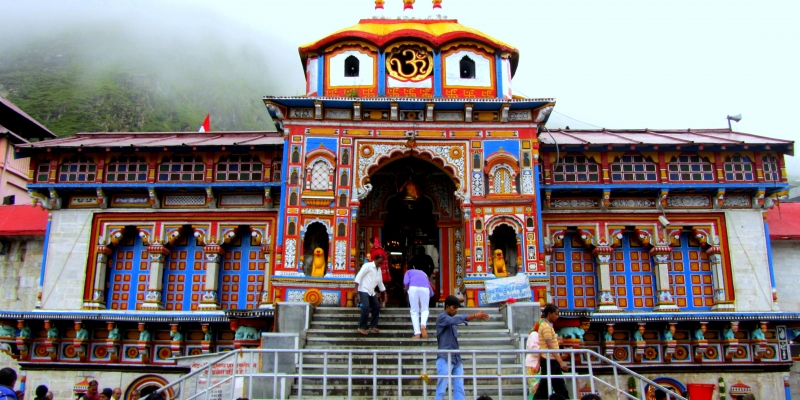
Built by Adi Shankaracharaya,
the philosopher-saint of the 8th century, the temple has been renovated several times due to damage by avalanches and restored in the 19th century by the royal houses of Scindia & Holkar. The main entrance gate is colorful & imposing popularly known as Singhdwar. References to Sri Badrinath have been made in the Vedas & perhaps it was a popular shrine during the Vedic age also. The Skand Purana gives an accvount of the Adiguru consecrating the idol of Lord Badri Vishal in the temple after recovering it from Narad Kund, in a pursuance of a divine call from heaven. The idol is made of black stone similar to granite. So holy is the shrine that it forms one of the four prominent places of Hindu worship.
The epic Mahabharat,
it is believed, was composed in the Vyas & ganesh caves close by. The Vishnu Ganga which later becomes the Alaknanda flows below the temple. Almost 3 km north of Badrinath, mana is the last Indian village before the Tibetan border. The Vasudhara falls are quite spectacular. On the closing day the residents of Mana offer a choli to the deity to cover the deity all the winter. It is taken off on the opening day & its fibers are distributed amongst the Yatris (pilgrims) as a maha prasadam. Joshimath is the winter deity of Badrinath. The temple opens every year in the month of April-May & closes for winters in the third week of November. Badrinath four subsidiary Badris include Bhavishya Badri, Yogdhyan Badri, Bridha Badri and Adi badri.
It is popularly believed that with spread of Buddhism, the Buddhists enshrined the statue of Lord Buddha there and during the Hindu renaissance, the statue of Buddha was later restored by Adi Guru as the idol of Vishnu. This possibly explains the deity sitting in Padmasan posture, typical of Buddha icons. However, also according to Hindu mythology, Buddha was considered to be the ninth incarnation of Lord Vishnu. Badrinath is devoted t the worship of Vishnu, who, according to an amusing tale, usurped this place from Shiva. For Vishnu had come here as the gods once did, to offer penance. He loved the place so much that he plotted to unseat Shiva from his meditation here. He took on the form of a beautiful child and began to wail.
Shiva's wife, Parvati,
picked him up but could not calm the child. Since his wailing continued to disturb Shiva, he shifted to Kedarnath in exasperation, leaving the spot free for Vishnu to occupy. But reminders of Shiva's stay continue to linger, most visible in the name, Badri, a kind of berry that Shiva was most fond of and the gigantic tree, invisible to the mortal eye, that served Shiva. Legend also has it, when the Ganga was requested to descend to earth to help the suffering humanity, the earth was unable to withstand the force of its descend.
Therefore the mighty Ganga was split into twelve holy channels, Alaknanda was one of them that later became the abode of Lord Vishnu or Badrinath. Dedicated to Lord Vishnu, it is built in the form of a cone with a small cupola of a gilt bull & spire. Legend dates the temple prior to the vedic age and the original temple is believed to be built by King Pururava and the icon of the lord carved by Vishwakarma, the creator of gods. A Hindu reformist Adi Shankaracharya re-enshrined the temple back in 8th century. A flight of steps takes pilgrims to the main gate & then into the temple.
The temple is divided into three parts - the 'Garbha Griha' or the sanctum sanctorum, the 'Darshan Mandap' where the rituals are conducted and the 'Sabha Mandap' where devotees assemble. The Garbha Griha portion has its canopy covered with a sheet of gold offered by Queen Ahilyabai Holkar. The complex has 15 idols. especially attractive is the one-meter high image of Badrinath, finely sculpted in black stone. It represents Lord Vishnu seated in a meditative pose-padmasan
Special Pujas
Are also performed on behalf of individuals. Every puja must be preceded by a holy dip in the Tapta Kund. Some of the special morning pujas are Abhishek, Mahaabhishek, Geeta Path. Some special evening pujas are Aarti & Geet Govind. Such pujas are to be booked in advance. The temple opens at 0430 hrs & closes at 1300 hrs. Once again it opens at 1600 hrs & closes at 2100 hrs after the divine song Geet Govind. Rawal is the administrator-Pujari of the temple well versed in puja ceremonials & Sanskrit language and is expected to be celibate.
Cradled in the Nar-Narayan mountain ranges with the grand Neelkanth peak forming an enchanting backdrop, Badrinath is one of the holiest Hindu pilgrimages. It is located on the left bank of river Alaknanda in Chamoli district of Uttarakhand. According to legends, the Badrinath temple dates back to the Vedic age. However, the present temple is believed to have been established by saint-philosopher Adi Shankaracharya. Badrinath along with Yamunotri, Gangotri and Kedarnath form the Chota Char Dham, one of the important pilgrimages for Hindus. Chota Char Dham is often confused with the Char Dham (four abodes or centers of pilgrimage) pilgrimage necessary for Hindus to perform in their lifetime.
Badrinath temple along with the temples at Puri, Dwarka and Rameswaram form the Char Dhams.
Badrinath, at 3,133 metres, remains covered in snow for over six months. During the period, the temple remains closed and the deity, Lord Badrinath, is shifted to Joshimath, one of the four Maths (monasteries) established by Shankaracharya. Gangotri, Yamunotri and Kedarnath temples also close at the same time. Though road access to Badrinath has improved, safety is a major concern. Landslides and road accidents are a regular occurrence.
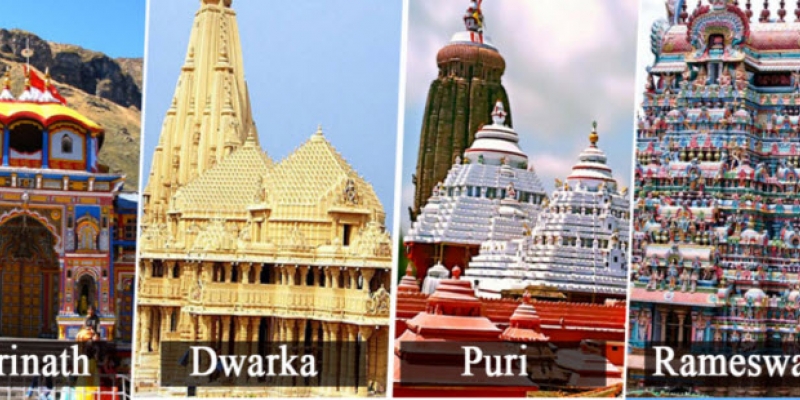
The road to Badrinath remains crowded since the route also leads to Hemkund Sahib, an important Sikh pilgrimage site. All motorized transport from Joshimath is obliged to move in convoys and the road is closed at night. The route to Badarinath is very fascinating with hilly terrain, hairpin bends and scenic Himalayan vistas.Hot water springs are among the natural wonders at Badrinath.Devprayag, Rudraprayag, Karnaprayag, Nandaprayag, Vishnuprayag and Pandukeswar are among the other pilgrimage sites on the route to Badarinath.
Best Places to stay in Badrinath
Since the town hosts large crowds of pilgrims from all over the country during summer it is advisable to book your accommodation in advance. As it is located in the mountains, no air conditioning is needed in Badrinath. In addition to hotels, there are several ashrams in Badrinath which offer accommodation. Ashrams are quite cheap and also provide food at minimal costs. Ashrams cost less than Rs 100 a day, but do not provide any luxury services.
Economy class rooms cost lesser than most other tourist places. ‘Luxury’ suites cost at least Rs 3,000. Tourists are allowed to pitch their own tents and one can get ready made tents from local shops. However, it is advisable to stay in hotels that provide easy access to the temple and main parts of the town.
Best Places to Eat In Badrinath
Since it is a pilgrimage site, restaurants here serve only vegetarian food. (Permit to serve non-vegetarian food ends at Rishikesh.)The food services at Badrinath are seasonal and so there is hardly anything available off-season. Hotels also don’t serve alcohol since they do not have a permit.

